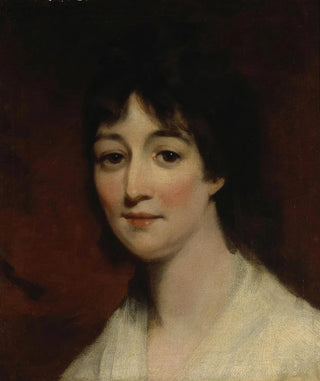Art print | Portrait of Lady Cavendish - John Hoppner


View from behind

Frame (optional)
Captivating Introduction
The "Portrait of Lady Cavendish" created by John Hoppner is an iconic artwork that embodies the elegance and sophistication of early 19th-century British portraiture. This painting, which delicately captures the beauty and charisma of its subject, is much more than a simple representation; it reflects an era where art and society are inextricably intertwined. Through this piece, Hoppner invites us to delve into the intimacy of an aristocrat, while offering a window into the conventions and aspirations of her time. The "art print Portrait of Lady Cavendish - John Hoppner" allows for rediscovering this masterpiece from a new perspective, highlighting its subtle details and timeless allure.
Style and uniqueness of the work
Hoppner's style is distinguished by his meticulous attention to detail and skillful use of light. In the "Portrait of Lady Cavendish," the way he renders the textures of fabrics and the reflections of light on her skin demonstrates his exceptional talent. The composition of the painting, centered on Lady Cavendish's figure, creates an atmosphere of closeness and intimacy. The chosen colors, with soft and harmonious tones, emphasize the delicacy of the protagonist's face while highlighting her presence. Lady Cavendish's slightly turned pose suggests both confidence and vulnerability, offering a fascinating duality that invites the viewer to question her personality. Every element, from the choice of accessories to the background, contributes to telling a story that goes beyond a simple portrait.
The artist and his influence
John Hoppner, born in 1758, made his mark as a portraitist of British high society. Raised in an artistic environment, he developed a style that combines classicism with a more romantic approach, thus standing out from his contemporaries. Hoppner had the opportunity to paint many influential personalities, and his work was praised for his ability to capture not only appearance but also the essence of his subjects. His influence extends well beyond his time

Matte finish

View from behind

Frame (optional)
Captivating Introduction
The "Portrait of Lady Cavendish" created by John Hoppner is an iconic artwork that embodies the elegance and sophistication of early 19th-century British portraiture. This painting, which delicately captures the beauty and charisma of its subject, is much more than a simple representation; it reflects an era where art and society are inextricably intertwined. Through this piece, Hoppner invites us to delve into the intimacy of an aristocrat, while offering a window into the conventions and aspirations of her time. The "art print Portrait of Lady Cavendish - John Hoppner" allows for rediscovering this masterpiece from a new perspective, highlighting its subtle details and timeless allure.
Style and uniqueness of the work
Hoppner's style is distinguished by his meticulous attention to detail and skillful use of light. In the "Portrait of Lady Cavendish," the way he renders the textures of fabrics and the reflections of light on her skin demonstrates his exceptional talent. The composition of the painting, centered on Lady Cavendish's figure, creates an atmosphere of closeness and intimacy. The chosen colors, with soft and harmonious tones, emphasize the delicacy of the protagonist's face while highlighting her presence. Lady Cavendish's slightly turned pose suggests both confidence and vulnerability, offering a fascinating duality that invites the viewer to question her personality. Every element, from the choice of accessories to the background, contributes to telling a story that goes beyond a simple portrait.
The artist and his influence
John Hoppner, born in 1758, made his mark as a portraitist of British high society. Raised in an artistic environment, he developed a style that combines classicism with a more romantic approach, thus standing out from his contemporaries. Hoppner had the opportunity to paint many influential personalities, and his work was praised for his ability to capture not only appearance but also the essence of his subjects. His influence extends well beyond his time






